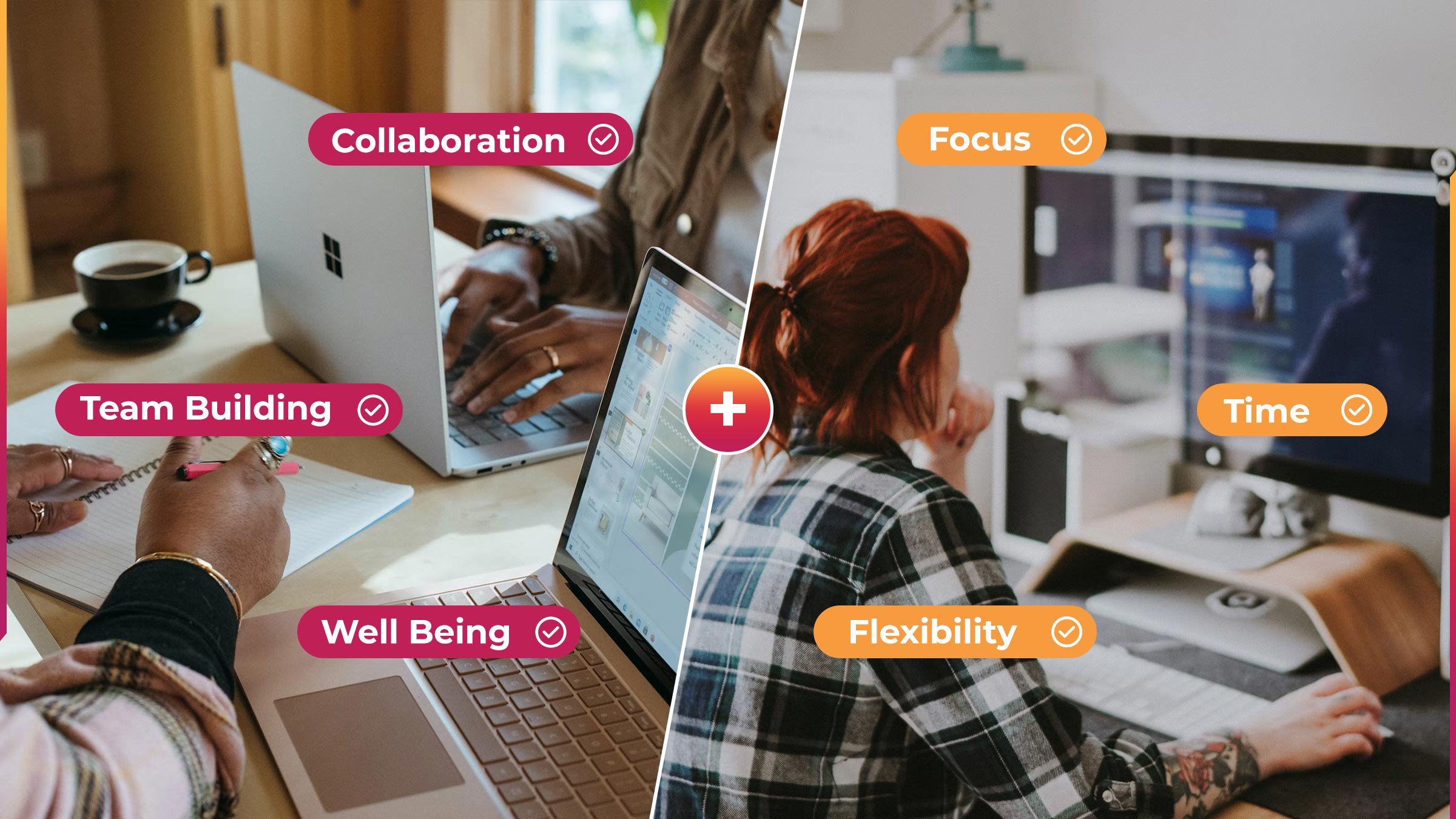The worldwide events of 2020 threw “normal” out the window. Lockdowns changed how we worked and played, and how we interacted with people. Many people began working from home.
Now that we’re emerging from lockdowns and restrictions heading back into the wild, the model for working has changed. Many realised there are some real benefits to working from home, but some businesses still are looking for employees to be working from the office.
That’s where the hybrid model of working has been born. A mix of both home and office working, early morning working or late night sessions. Where does your business stand with this new model? What operational model would work best for your team? For training on how to create the best operations, The Entourage has business training you can enroll in and learn a whole lot.
What are the current working models?
Working from office
You could consider this model as the traditional employee model. You would get yourself into the office, work 9 to 5, and then get yourself home again. This way of working has good points and not so good points:
Advantages
- Quick communication: You can have a meeting, discuss issues and have an action plan, in the time it takes to walk from the kitchen back to your desk.
- Functional Design: Modern offices are designed to encourage work. They have functional meeting rooms, ergonomically designed office spaces and more. It is a place of work.
- Collaboration: Being in the same space as your work colleagues enables free-flowing ideas and conversation, which helps with teamwork and collaboration on projects.
Disadvantages
- Lack of Privacy: Anyone can walk up and interrupt you at any time. Even if you’re wearing headphones, people can still stop your flow of work to talk.
- Increased stress: Perhaps you feel the need to work harder, or you’re under the watchful eyes of management. This can be stress-inducing and impact your ability to work.
- Wasted time: Some people consider the transit time to and from work as dead time, wasted.
Working from home
Working from home has been a wonderful experience for many people. Switching to online forums and Zoom meetings, being able to give your cat head scratches whenever it wants. For others, blurring the line between work and home life was difficult.
Advantages
- Comfortable environment: It is your home environment, and you can decorate as you see fit. This freedom lets you shape a space that truly feels like your own. A few plants, a comfy chair, or even Vintage Wall Art Canvas Prints can add just the right touch to freshen up the atmosphere and lift your mood while working. You can have your music, dress how you please, within reasons. You could work outside if the weather permitted.
- Easy transit: You’re not stuck in traffic, squeezed into crowded train carriages. If you’re organised, you can be out of bed and at work in moments.
- Flexible working arrangements: Not needing to be “on” for the 8 hours in the office freed up people’s work schedules. Need a five-minute rest? Take it. Go for a walk, get more snacks from the kitchen. Many businesses relaxed their working times during the work from home times.
Disadvantages
- Distractions: It is easier to lose focus on what you’re doing. The dog wants to go for a walk; daytime TV is just in another room. There are dishes to do and many more ways to distract yourself from your work.
- Never leaving home: When you finish work for the day, you don’t “leave the office”. You’re still in the same place. This can lead to cabin fever.
- Equipment costs: If you haven't worked from home before, it can cost a fair bit of money to set yourself up correctly. You can only work on the kitchen counter for so long before you need more dedicated working space.
What are the potential problems with both working models?
No working model, in isolation, is perfect. If you’re going to the office five days a week, what can begin as a minor annoyance can soon turn into a major roadblock.
Does Simon talk loudly on the phone? Is Anna always five minutes late back from her breaks? Does Mariah have a better desk than you do?
The same can be said about working from home. While it may be fun to relax in your chair wearing your pyjamas, not getting out of the house and not getting dressed for the day can really bring your mood down and give you some mental health issues.
These minor issues, which can grow, will drag you down and reduce your workflow.
Hybrid working is good to keep you refreshed. It helps to reduce complacency. A change of scene can give you a positive change of mood.
Hybrid working model
The hybrid working model is more than just working from the office and working from home. It is a combination of when you work best and where you work best.
Some people are more productive in the mornings, while others are night owls and get work done once the sun has gone down.
You might enjoy the ease of working from home in your pyjamas, while other people need the separation of work and home and enjoy the office environment.
The hybrid model of work is shifting the focus from how many hours you work to how much you produce, getting the job done. Employees are happier, and more work is getting done.

Why is the hybrid working model so great?
This hybrid model is great as it gives more agency to employees. They’re still expected to do the job, but they get to choose when to do the work, which best suits them.
Rather than being expected to be in the office, 9 - 5, or always online for the same times, the responsibility is being given to the employee to get the work done when it suits them. As long as it gets done.
The hybrid model allows businesses to save on real estate, with smaller office spaces needed with an agile workforce.
With remote working opportunities, geography is no longer a restricting factor in hiring. You can hire talent from anywhere around the globe to work with your team.
Home internet providers part in the hybrid working model
Home internet providers play a huge role in ensuring the success of a hybrid working model. Employees rely heavily on a stable and fast internet to stay productive, so the quality of home internet directly affects their ability to complete tasks. Collaborative tools, video conferencing, and cloud-based applications require reliable connectivity. So choosing an adequate home internet provider is extremely important. As businesses expand globally with remote teams, providing employees with reliable internet service at home becomes even more crucial to ensure there is smooth communication and workflow in a hybrid work environment. Home internet providers play a big part in providing this access.
What type of businesses can a hybrid working model be good for?
This hybrid model suits some businesses more than others, for sure. Businesses that are purely online, such as marketing agencies, or shipping agencies, benefit from the hybrid model.
Call centres switched to a hybrid model quite well, giving their employees headsets and remote access. In many cases, without the background noise of a call centre, customers had a better experience.
A lot of jobs that are computer heavy, such as data entry, writing jobs, bookkeepers and accountants and the like, these roles and more are well-suited to remote and hybrid working arrangements.
Some roles which wouldn’t work with a hybrid model include retail with a storefront, or if you’re a warehouse manager, part of the supply and distribution chain.
Conclusion
Businesses want the best output from their employees, and they want their employees to be happy. Switching to a hybrid model of working seems to be a win-win situation for all parties. You can allow your team to be productive when they want to be and give them some ownership of their work process. If you work best in the office, then come on in. If home produces the best results, that's good for you.
The idea of a hybrid working model, and other great ways to run your business, is given to you in our business training courses. Check out the other courses, sign up and become a better business owner today.
Related Categories
Ryan Terrey
As Director of Marketing at The Entourage, Ryan Terrey is primarily focused on driving growth for companies through lead generation strategies. With a strong background in SEO/SEM, PPC and CRO from working in Sympli and InfoTrack, Ryan not only helps The Entourage brand grow and reach our target audience through campaigns that are creative, insightful and analytically driven, but also that of our 6, 7 and 8 figure members' audiences too.





